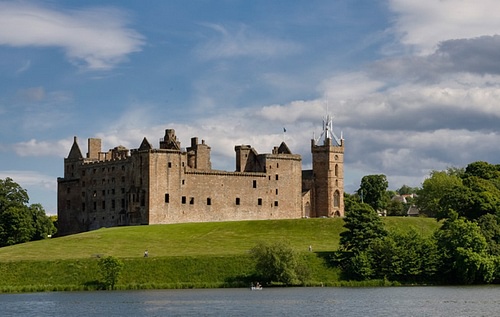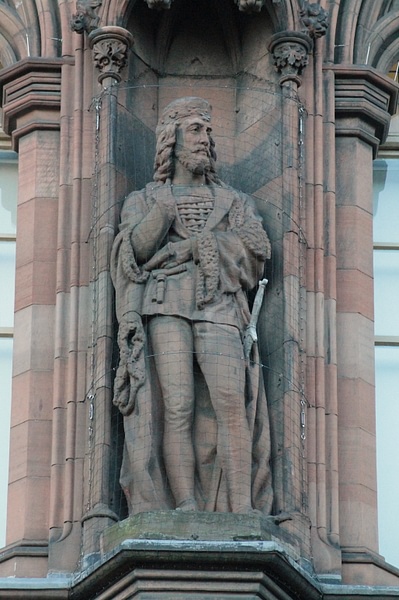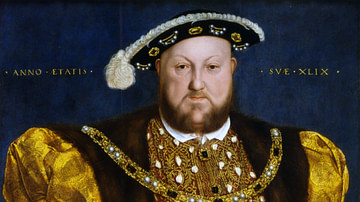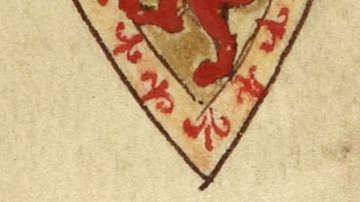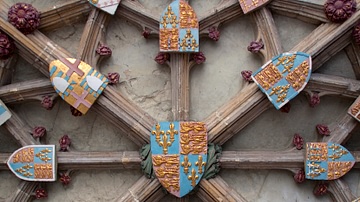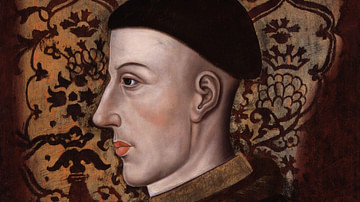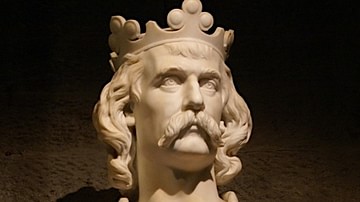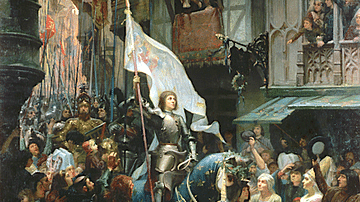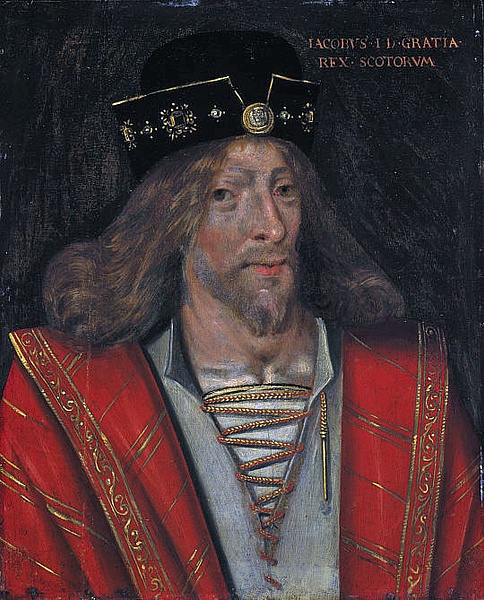
James I of Scotland ruled as king from 1406 to 1437. In 1406, the future king was captured by pirates and then imprisoned by Henry IV of England (r. 1399-1413), a confinement that lasted for 18 years. He succeeded his father Robert III of Scotland (r. 1390-1406) but in James' absence, Scotland was ruled by his uncle the Duke of Albany (l. 1339-1420). James finally returned to Scotland in 1424, but his harsh treatment of the nobility, unpopular fiscal policies, and a failed siege of Roxburgh Castle culminated in his assassination in 1437. He was, nevertheless, succeeded by his son James II of Scotland (r. 1437-1460) who continued the royal Stewart line.
Early Life
James was born on 25 July 1394 at Dunfermline Palace into the royal house of Stewart which had been founded by Robert II of Scotland (r. 1371-1390) and which continued with Robert III of Scotland (r. 1390-1406), James' father. Robert III had been incapacitated in a riding accident in 1388 and so the daily governance of the kingdom was taken over by his brother Robert, Earl of Fife (aka Duke of Albany). Scotland was at this time torn by the bitter rivalries which had been created by Robert II's wholesale land and title redistributions and his large number of competing offspring. In 1399, a royal council elected Robert III's son David as the King's Lieutenant. This move only increased the crisis, and the Duke of Albany took radical action in March 1402, imprisoning his nephew and leaving him to starve to death (the official reason for death was 'divine providence'). Albany declared himself regent and Robert III, fearing for the future of his kingdom and young son James, sent the 11-year-old prince to find safety in France. Unfortunately, the escape plan went badly wrong.
Imprisonment
Prince James was captured after the Hanseatic ship in which he was travelling to France was taken by pirates and wrecked on the east coast of England off Flamborough Head on 22 March 1406. The prince was captured and presented to the king for a suitable fee. Henry IV of England then imprisoned his fellow royal in such residences as Windsor Castle, the Tower of London, and Nottingham Castle. Henry demanded a huge ransom for James' release, but his father had died shortly after his capture and so, even if James did officially become king, nobody was forthcoming with the cash, least of all the Duke of Albany who remained regent until his death in September 1420. The duke, in contrast, had managed in 1416 to secure the release of his own son, Murdoch Stewart (l. c. 1362-1425), who was likewise languishing in an English prison. Murdoch succeeded his father as the regent in 1420.
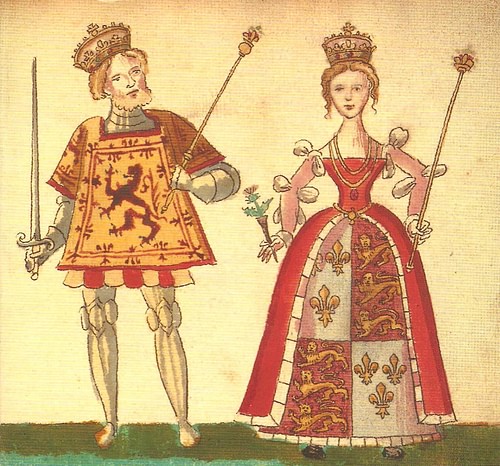
At least the king's confinement was a comfortable one, and in the meantime, the two countries maintained an uneasy truce. Diplomatic relations were furthered when James married Lady Joan Beaufort (c. 1400-1445), a niece of Henry IV and daughter of the Earl of Somerset, in February 1424. The couple would have eight children, although six were girls and only one boy, James (b. October 1430), survived infancy. The imprisoned king was near the end of his ordeal, but he still had plenty of time at his disposal to write a 379-line poem in praise of his wife's beauty, The Kingis Quair ('The King's Book'). Although a poem on courtly love, it does contain some passages which reflect the king's thoughts on his confinement such as:
The bird, the beast, the fish eke in the sea,
They live in freedom each one in his kind;
And I a man, and lacketh liberty;
What shall I say, what reason may I find,
That fortune should do so? Thus in my mind
My case I would argue, but all for nought:
There was no-one to give my woes a thought.
(Jones, N. 86)
The king had also honed his skills in music, archery, wrestling, and medieval jousting during his captivity. Indeed, the king's martial skills had been put to good use by Henry V of England (r. 1413-1422), who used James in his campaigns in France in 1420 during the Hundred Years' War (1337-1453). The pair must have got on as Henry knighted James and invited him to join the prestigious and highly select chivalric Order of the Garter in April 1421.
Return to Scotland
James finally returned to Scotland in April 1424 after his ransom of £40,000 - to be paid in instalments - was agreed upon (equivalent to over £25 million today). As part of the deal, 27 Scottish nobles were handed over to the English as hostages until the ransom was fully paid up. The king was crowned in May, and he was not slow to avenge his noble's lack of enthusiasm in paying his ransom and securing his release much earlier. The Duke of Albany had escaped James' wrath, but his family did not, and many were executed, including Murdoch Stewart in May 1425. A general purge of disloyal officials and selected clan leaders followed. The Highland clans were brought further under royal control, notably the MacDonalds. James then set about systematically dispossessing earls of their earldoms so that he eventually controlled a great many of them himself (Fife, Strathearn, Mar, March, Garioch, Lennox, and Annandale, to name a few). The king did not let the general populace off lightly either; taxes were raised, fishing was prohibited out of season, rules were made as to what kinds of clothes certain classes could wear, and oddly enough, football was banned.
The king did improve local justice and widened the membership of Parliament to include lesser nobles. Parliament also became a legislative body along the lines of the English version, regularly passing statute laws. Many of these new laws, as noted, imposed petty restrictions on everyday life, and many of them, too, were entirely unenforceable such as one ruling that all rooks' nests should be removed from trees. Further, these legislative developments did not impress the lawless nobles who had been enjoying full independence during the king's confinement. James pressed on regardless and entrenched the Stewarts as the great ruling family with a splendid round of spending on public projects and palaces such as at Linlithgow with its new Great Hall.
In terms of foreign policy, James paid mere lip service to his treaty commitments with France, largely preferring instead to leave England and that kingdom to squabble amongst themselves on the Continent. Diplomatic ties were strengthened with France when James promised his daughter Margaret in marriage to Louis, heir to the French throne in 1436. There was one military dalliance in August 1436, and this was in a siege of Roxburgh Castle - still held by the English. James only succeeded in having his train of new cannons captured, an expensive and humiliating loss.
Perhaps not surprisingly with all this reshuffling and reassertion of royal power, many in the kingdom rather wished their king was still in the Tower of London. Few wished to see an escalating war with England, and Parliament refused the king's attempt to raise taxes. James was accused of enjoying too lavish a lifestyle at court, his easy living all too evident in his burgeoning physique, described by one chronicler as "thick-set and oppressed by too much fat" (Cannon, 152). In trying to imitate the courts of England and France, James spent prodigious sums on fine clothes, jewellery, and furnishings. Only the first two ransom instalments due the English Crown were paid and so a major justification for the high taxes was absent. Even when James did finally persuade Parliament to levy a new tax in 1431, the condition attached was that the revenue must be kept in a strongbox which the king could not access for his own spending sprees. The Scots' patience with their extravagant and authoritarian king was fast running out.
The final straw may have been James' formal decision to stop paying the ransom altogether, even if several Scottish nobles were being held hostage. A small group of radical barons - some of whose heirs were hostages - were determined on action, and, led by Walter, Earl of Athol, the king's uncle, they conspired to arrest the king in Parliament. When this strategy failed, more drastic action was taken. The king was assassinated in the monastery of Friars Preachers in Perth on 21 February 1437. In one version of the confused events, a lady tried to block the door to the king's chambers using only her arm, which was then broken. The king escaped into the sewers but was discovered by his assassins and stabbed to death. Queen Joan was present and just managed to escape, although she was herself wounded in the episode. Unforeseen by the king's murderers, the nobility rallied around Queen Joan and her young son James. Regicide, it seemed, remained an unforgivable crime no matter how despised the monarch. The assassins of James I were rounded up, tortured, and executed; one of them was said to have had a burning-hot iron crown placed on his head.
Death & Successor
James I had died aged 43, and he was buried in the Carthusian Priory of Perth. He was succeeded by his son James, who became James II of Scotland. The new king was still a minor and so there followed the all-too-familiar pattern of nobles jostling for control of the king and his kingdom. Intrigues, murders, and executions were followed by a civil war between the Douglases and those families loyal to the Crown. James II won that war but was killed in 1460 when the cannon he was standing next to exploded during a siege of Roxburgh Castle. It seems the Stewart kings were either accident-prone or terribly unlucky, but the line continued through the remainder of the medieval period and beyond when James VI of Scotland (r. 1567-1625) became James I of England (r. 1603-1625), unifying the two kingdoms under a single monarch.
